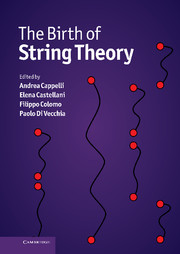Book contents
- Frontmatter
- Contents
- List of contributors
- Photographs of contributors
- Preface
- Abbreviations and acronyms
- Part I Overview
- EARLY STRING THEORY
- Part II The prehistory: the analytic S-matrix
- Part III The Dual Resonance Model
- Part IV The string
- TOWARDS MODERN STRING THEORY
- Part V Beyond the bosonic string
- Part VI The superstring
- 35 Introduction to Part VI
- 36 Supersymmetry in string theory
- 37 Gravity from strings: personal reminiscences of early developments
- 38 From the Nambu–Goto to the σ-model action
- 39 Locally supersymmetric action for the superstring
- 40 Personal recollections
- 41 The scientific contributions of Joël Scherk
- Part VII Preparing the string renaissance
- Appendix A Theoretical tools of the Sixties
- Appendix B The Veneziano amplitude
- Appendix C From the string action to the Dual Resonance Model
- Appendix D World-sheet and target-space supersymmetry
- Appendix E The field theory limit
- Index
35 - Introduction to Part VI
from Part VI - The superstring
Published online by Cambridge University Press: 05 May 2012
- Frontmatter
- Contents
- List of contributors
- Photographs of contributors
- Preface
- Abbreviations and acronyms
- Part I Overview
- EARLY STRING THEORY
- Part II The prehistory: the analytic S-matrix
- Part III The Dual Resonance Model
- Part IV The string
- TOWARDS MODERN STRING THEORY
- Part V Beyond the bosonic string
- Part VI The superstring
- 35 Introduction to Part VI
- 36 Supersymmetry in string theory
- 37 Gravity from strings: personal reminiscences of early developments
- 38 From the Nambu–Goto to the σ-model action
- 39 Locally supersymmetric action for the superstring
- 40 Personal recollections
- 41 The scientific contributions of Joël Scherk
- Part VII Preparing the string renaissance
- Appendix A Theoretical tools of the Sixties
- Appendix B The Veneziano amplitude
- Appendix C From the string action to the Dual Resonance Model
- Appendix D World-sheet and target-space supersymmetry
- Appendix E The field theory limit
- Index
Summary
Introduction
By 1973 two ghost-free dual models had been constructed, the Dual Resonance Model and the Ramond–Neveu–Schwarz model. The structure underlying the DRM was that of a relativistic string described by the Nambu–Goto action, but it was not clear yet which kind of string was underlying the RNS model. These models were not suitable for describing strong interactions because they both had massless particles with spins one and two in their spectra (together with a tachyon). An additional problem was raised by the deep inelastic experiments: probing the structure of protons at short distances, they showed the existence of pointlike particles that could be interpreted as the quarks. As already mentioned, string theory scattering amplitudes were too soft at large momentum transfer to explain these experiments. Therefore many researchers went back to field theory; in particular, quantum chromodynamics (QCD), the non-Abelian gauge theory for quarks and gluons formulated in 1972, was intensively studied in the following years obtaining convincing experimental support.
Although these events implied that dual theories could not correctly describe the hadronic processes, they did not completely put an end to their study. In fact, some of the earlyworkers in this field were so attracted by the consistent and deep structure of these models that they continued to study them, sometimes at the price of putting their careers at risk.
- Type
- Chapter
- Information
- The Birth of String Theory , pp. 421 - 446Publisher: Cambridge University PressPrint publication year: 2012



